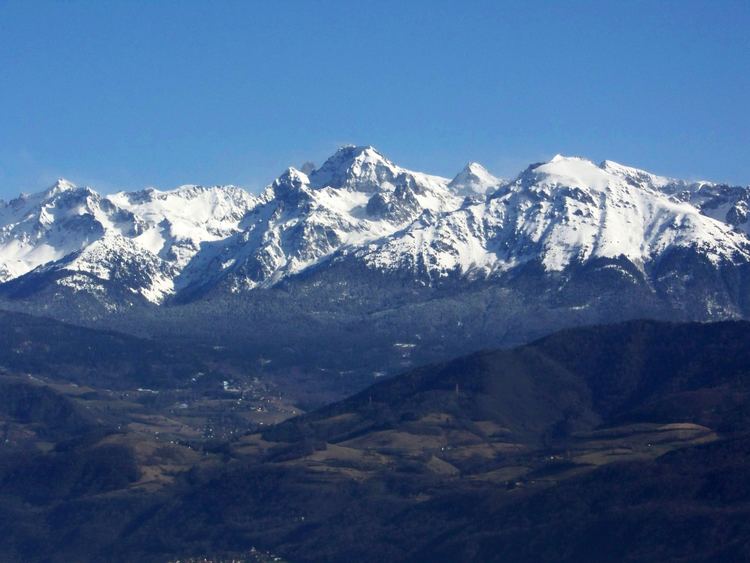Length 60 km (37 mi) Elevation 2,977 m Country France | Width 10 km (6.2 mi) Highest point Grand Pic de Belledonne | |
 | ||
Peak Grand Pic de Belledonne Mountains Croix de Belledonne, Grand Pic de Belledonne, Pic du Frêne Similar Chartreuse Mountains, Alps, Vercors Massif, Les sept Laux, Grésivaudan | ||
Un petit tour en belledonne
Belledonne (French: La chaine de Belledonne) is a mountain range (French: massif) in the Dauphiné Alps (part of the French Alps) in southeast France. The southern end of the range forms the eastern wall of the mountains that surround the city of Grenoble.
Contents
- Un petit tour en belledonne
- Map of ChaC3AEne de Belledonne 38190 Laval France
- Traverse e de belledonne 2015
- Geography
- Main glaciers
- Main passes
- Main lakes
- Ski resorts
- Origin of the name
- Fauna
- References
Map of Cha%C3%AEne de Belledonne, 38190 Laval, France
The range is noted for the spectacular scenery it provides the inhabitants of Grenoble, numerous ski areas, interesting geology, and a diverse range of alpine land types and uses.
Traverse e de belledonne 2015
Geography
The Belledonne range is approximately 60 km (37 mi) long by between 10 km (6.2 mi) wide and runs from roughly 45°03′N 5°48′E, 16 km (9.9 mi) south-south-east of the city of Grenoble, in a north-easterly direction (actually 35 degrees) for 65 km (40 mi) to roughly 45°33′N 6°17′E, near the town of Aiguebelle. The highest point is the Grand Pic de Belledonne, 2,977 m (9,767 ft).
The range is delineated by several valleys which lie at relatively low altitude, including the Grésivaudan Valley (which carries the Isère River) on the west, the Arc River to the north and the Romanche River to the south. The range counts dozens of peaks over 2,500 m (8,200 ft), more than 10 glaciers, and many alpine lakes, the highest of which is over 2,400 m (7,900 ft) above sea level.
Geologically, Belledonne is a concatenation of ranges which are not physically separated; from north to south, these are: the Grand Arc, the Lauzière, the Sept-Laux, Belledonne proper, and the Taillefer.
Belledonne is a crystalline range. It initiated as a Paleozoic peneplain which was covered by Mesozoic sediments, then raised and tilted during the Tertiary uplift of the Alps and subjected to glacial erosion during the Quaternary. As a result of its geologic history, Belledonne alternates jagged peaks with gentle slopes.
Belledonne overlooks the fairly flat Isère Valley (French: Grésivaudan) which lies only 220 m (720 ft) above sea level near Grenoble. Hence, all alpine vegetation zones are represented:
A significant feature is the Belledonne Balcony (French: Le Balcon de Belledonne), which is a terrace or plateau some 30 km long on the western side of the range that provides a relatively level area intersected by narrow ravines eroded by rivers taking runoff from the snow levels higher up. The Balcony has supported diverse livestock-raising and other agricultural activity for a considerable period of time.
Main glaciers
The most spectacular glacier in Belledonne is French: Glacier de Freydane, which is noted for its crevasses.
Main passes
There is no road that cuts across Belldonne. The Pas de la Coche pass is the only natural break point in the range, between Belledonne proper and the 7 Laux range. It is the only point below 2,000 metres (6,600 ft) on the Belledonne ridge (the main water divide between the Isère river and the Romanche river). Most other passes are not much lower in elevation than their neighboring peaks. At the turn of the 20th century, Joseph Paganon, a minister in several French governments, pushed for linking Laval to the Rivier-d'Allemont by road D528. But the roadwork stopped at an elevation of 1,336 metres (4,383 ft) on the Gresivaudan side, while work never even started on the other side (Eau d'Olle). Before the automobile era this pass was frequently used by locals to go from Gresivaudan to the Eau d'Olle valley, or even to go to the Maurienne valley via the Glandon pass. Hannibal is believed to have passed the Pas de la Coche when he crossed the Alps with his army.
Main lakes
Belledonne and its lakes have played a major role in industrializing hydroelectricity production as early as 1869 thanks to pioneer Aristide Bergès and his paper mills which tapped water from lake Crozet.
Ski resorts
There are 4 main ski resorts in Belledonne, from South to North:
Origin of the name
The origin of the name is not clear. The phrase belle donne means beautiful women in Italian. It does not appear to mean that in Arpitan, and since Arpitan is the ancient regional language, would have been a more likely source of ancient names than Italian. Nevertheless, from one angle the highest peak, the Grand Pic du Belledonne allegedly looks like a woman holding a baby. Other suggested derivations are from the Celtic donne meaning valley, hence beautiful valleys, or indo-European bal, meaning elevated rock, which evolved into bel, then belle. It is difficult without evidence to determine the validity of these derivations.
Fauna
The mountains are home to marmots, chamois, ibex mountain goats and grouse. Reportedly, wolves have returned since 1998, coming from Italy and the press regularly echoes complaints from shepherds about wolves attacking their sheep .
The ibex had completely disappeared from Belledonne. Early 1983, 13 females and 7 males were brought in from Switzerland and by spring 2002, their population had risen to 900 heads.
